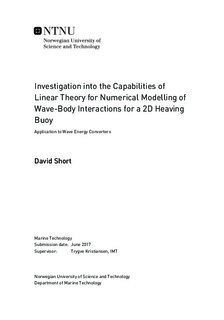Investigation into the Capabilities of Linear Theory for Numerical Modelling of Wave-Body Interactions for a 2D Heaving Buoy - Application to Wave Energy Converters
Master thesis
Date
2017Metadata
Show full item recordCollections
- Institutt for marin teknikk [3428]
Abstract
Numerical modelling of wave energy converters (WECs) is currently an area of interest within the marine renewable energy industry, due to its ability to streamline design processes and accelerate scientific understanding. The presented project investigates the capacity of linear potential flow theory to accurately model wave excitation of a 2D WEC buoy-section, identifying wave conditions under which computational fluid dynamics (CFD) become a more appropriate strategy. OpenFOAM® v1612+ is utilised to simulate fully non-linear, viscous wave-structure interactions for comparison with linear theory and experimental results. Regular waves are generated to study both fixed and floating body cases. Linear forces are compared with those computed during fixed body CFD simulations, the validity of which is investigated using wave flume experiments carried out in NTNU s Ladertanken wave flume facility. Experimental and numerical results show reasonable agreement. 1st harmonic CFD forces compare well with linear forces in cases where overtopping is not observed. 2nd harmonic loads are shown to have significant contributions to total forces. Floating body CFD simulations are carried out allowing heave response displacements to be obtained for comparison with linear theory predictions. For the tested cases, responses are dominated by 1st harmonics, making comparison with linear theory particularly interesting. Good agreement is seen between linear theory and CFD for wave frequencies far from the natural frequency in heave, however divergence is seen for steep waves close to resonance where overtopping is extensive.
